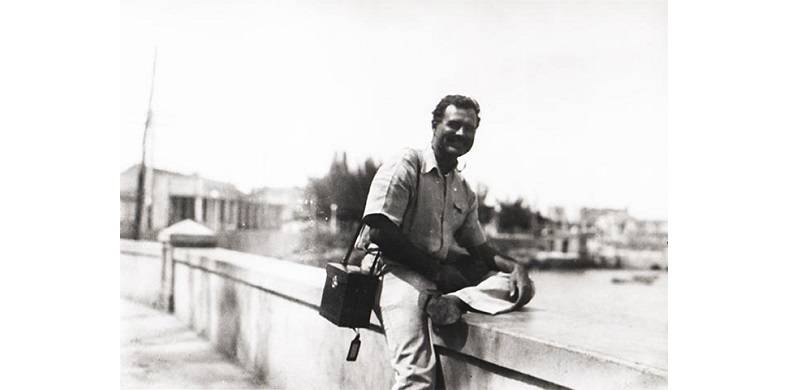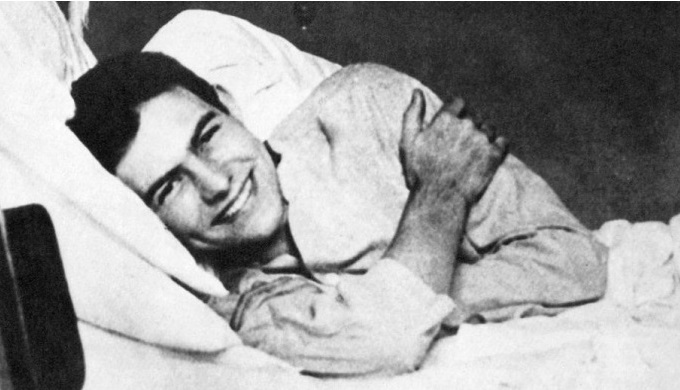
Paris, the legendary city of light, has been celebrated in numerous books and poems. Phrases such as “we will always have Paris,” drawn from the classic film Casablanca, considered to be one of the best movies ever made, have promoted its image as a city of romance and mystery. After the First World War, Paris became a favorite haunt of artists, intellectuals, writers and poets from around the world – who frequently congregated in its celebrated bookstores, cafés and restaurants.
The famed American author Ernest Hemingway, who won the Nobel Prize for Literature in 1954, spent some five years in Paris in the 1920s, working as a journalist and fiction writer. Those five years from 1925 to 1929 are considered to be the most productive phase of his life, during which he produced several novels. These include his first full novel, The Sun Also Rises (1926), which is based on his experiences in Paris and Spain; A Farewell to Arms (1929), which was heavily influenced by the author's experience in the First World War; and For Whom the Bell Tolls (1940), which drew on his observations during the bloody Spanish Civil War, which he covered as a newspaper reporter, became a bestseller.
Hemingway’s last fiction book, The Old Man and the Sea, written in Cuba and published in 1952, earned him a Pulitzer Prize, the highest US literary award, and was mentioned by the Nobel Committee in his Nobel Prize citation. The book narrates the story of an old fisherman and his struggle with a giant fish. He moved from place to place while working on his books.
According to many of his admirers, Hemingway's most endearing work A Moveable Feast is truly his masterpiece. Completed in 1960, it is a collection of anecdotes and memories from his early years in Paris when he was a young, fledgling writer, often strapped for money. The book was published posthumously in 1964 by his fourth wife Mary Welch, after the author's tragic death by suicide in 1961.
The book has been associated with an interesting and intriguing story. Apparently, in 1956, two boxes containing notebooks and some unfinished manuscripts were retrieved by Hemingway from a hotel basement in Paris, where they had been stored since 1928. Included in the retrieved material were the original notes and written sketches of people and places that he had encountered while he lived there. This disparate material, consolidated and processed, emerged some years later as A Moveable Feast.
Hemingway, who suffered from bouts of depression, worked diligently on the book during his stay in Cuba. However, it still lacked an introduction and the final chapter when the author died. The manuscript was edited and finalised by Mary Welch, who also chose the title from among random comments the writer had made and which were later quoted by a friend: “If you are lucky to have lived in Paris as a young man, the experience stays with you wherever you go, for Paris is a moveable feast.”
The book has generated controversy ever since it was published. Its second version — the restored edition — has fueled the debate even further. Sean Hemingway, the author's grandson, has made some significant additions and alterations in the text of the book, and even changed the sequence of the chapters. He contends, in the revised book's introduction, that the original version was not what his grandfather would have intended it to be. He argues that his step-grandmother Mary Welch had heavily edited it and removed passages that presented his second wife, Sean's grandmother, in a favourable light and portrayed Hemingway as an affable character.
 This assertion, however, is rebutted by A. E. Hotchner, a biographer and close friend of Hemingway, who in a New York Times op-ed article (July 2009) claimed that the author had already completed the book as he wanted it to be before his death, and it was unethical to edit and create a new version based on the personal whims of a family member. Since the original manuscript of A Moveable Feast is deposited with the Kennedy Library in Boston and accessible to researchers, the controversy is likely to stay as a subject of active polemic for some time among the literary community.
This assertion, however, is rebutted by A. E. Hotchner, a biographer and close friend of Hemingway, who in a New York Times op-ed article (July 2009) claimed that the author had already completed the book as he wanted it to be before his death, and it was unethical to edit and create a new version based on the personal whims of a family member. Since the original manuscript of A Moveable Feast is deposited with the Kennedy Library in Boston and accessible to researchers, the controversy is likely to stay as a subject of active polemic for some time among the literary community.
During a relatively brief writing career, Ernest Hemingway established himself as one of the foremost American fiction writers of the 20th century. His writing style is considered innovative, as he used simple declarative sentences and the least number of words that will convey the meaning – in place of the florid language which was commonly employed by 19th-century Victorian writers.
A Moveable Feast unfortunately reveals a less desirable trait of the author's personality. In its short chapters, he savages some of his close friends and benefactors – among them American authors Ezra Pound and F. Scott Fitzgerald – with caustic and unkind comments. Many of the injudicious remarks in the book have been attributed to the immaturity and youthful exuberance of the author at a time when he was still attempting to establish himself as a writer.
Hemingway bought a seaside house in Havana, Cuba, and lived there, off and on, for nearly two decades. He worked on or completed several of his landmark publications, including For Whom the Bell Tolls, A Moveable Feast and The Old Man and the Sea there. The old house has now been renovated and converted into a museum where his unpublished manuscripts and letters are housed and displayed. The availability of this treasure of previously unseen, original literary material is a virtual feast for the author's many fans and admirers.
The famed American author Ernest Hemingway, who won the Nobel Prize for Literature in 1954, spent some five years in Paris in the 1920s, working as a journalist and fiction writer. Those five years from 1925 to 1929 are considered to be the most productive phase of his life, during which he produced several novels. These include his first full novel, The Sun Also Rises (1926), which is based on his experiences in Paris and Spain; A Farewell to Arms (1929), which was heavily influenced by the author's experience in the First World War; and For Whom the Bell Tolls (1940), which drew on his observations during the bloody Spanish Civil War, which he covered as a newspaper reporter, became a bestseller.
Hemingway’s last fiction book, The Old Man and the Sea, written in Cuba and published in 1952, earned him a Pulitzer Prize, the highest US literary award, and was mentioned by the Nobel Committee in his Nobel Prize citation. The book narrates the story of an old fisherman and his struggle with a giant fish. He moved from place to place while working on his books.
According to many of his admirers, Hemingway's most endearing work A Moveable Feast is truly his masterpiece. Completed in 1960, it is a collection of anecdotes and memories from his early years in Paris when he was a young, fledgling writer, often strapped for money. The book was published posthumously in 1964 by his fourth wife Mary Welch, after the author's tragic death by suicide in 1961.
The book has been associated with an interesting and intriguing story. Apparently, in 1956, two boxes containing notebooks and some unfinished manuscripts were retrieved by Hemingway from a hotel basement in Paris, where they had been stored since 1928. Included in the retrieved material were the original notes and written sketches of people and places that he had encountered while he lived there. This disparate material, consolidated and processed, emerged some years later as A Moveable Feast.
Hemingway, who suffered from bouts of depression, worked diligently on the book during his stay in Cuba. However, it still lacked an introduction and the final chapter when the author died. The manuscript was edited and finalised by Mary Welch, who also chose the title from among random comments the writer had made and which were later quoted by a friend: “If you are lucky to have lived in Paris as a young man, the experience stays with you wherever you go, for Paris is a moveable feast.”
The book has generated controversy ever since it was published. Its second version — the restored edition — has fueled the debate even further. Sean Hemingway, the author's grandson, has made some significant additions and alterations in the text of the book, and even changed the sequence of the chapters. He contends, in the revised book's introduction, that the original version was not what his grandfather would have intended it to be. He argues that his step-grandmother Mary Welch had heavily edited it and removed passages that presented his second wife, Sean's grandmother, in a favourable light and portrayed Hemingway as an affable character.
 This assertion, however, is rebutted by A. E. Hotchner, a biographer and close friend of Hemingway, who in a New York Times op-ed article (July 2009) claimed that the author had already completed the book as he wanted it to be before his death, and it was unethical to edit and create a new version based on the personal whims of a family member. Since the original manuscript of A Moveable Feast is deposited with the Kennedy Library in Boston and accessible to researchers, the controversy is likely to stay as a subject of active polemic for some time among the literary community.
This assertion, however, is rebutted by A. E. Hotchner, a biographer and close friend of Hemingway, who in a New York Times op-ed article (July 2009) claimed that the author had already completed the book as he wanted it to be before his death, and it was unethical to edit and create a new version based on the personal whims of a family member. Since the original manuscript of A Moveable Feast is deposited with the Kennedy Library in Boston and accessible to researchers, the controversy is likely to stay as a subject of active polemic for some time among the literary community.During a relatively brief writing career, Ernest Hemingway established himself as one of the foremost American fiction writers of the 20th century. His writing style is considered innovative, as he used simple declarative sentences and the least number of words that will convey the meaning – in place of the florid language which was commonly employed by 19th-century Victorian writers.
A Moveable Feast unfortunately reveals a less desirable trait of the author's personality. In its short chapters, he savages some of his close friends and benefactors – among them American authors Ezra Pound and F. Scott Fitzgerald – with caustic and unkind comments. Many of the injudicious remarks in the book have been attributed to the immaturity and youthful exuberance of the author at a time when he was still attempting to establish himself as a writer.
Hemingway bought a seaside house in Havana, Cuba, and lived there, off and on, for nearly two decades. He worked on or completed several of his landmark publications, including For Whom the Bell Tolls, A Moveable Feast and The Old Man and the Sea there. The old house has now been renovated and converted into a museum where his unpublished manuscripts and letters are housed and displayed. The availability of this treasure of previously unseen, original literary material is a virtual feast for the author's many fans and admirers.

